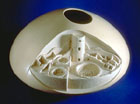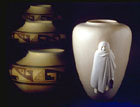The potters whom I know seem to be imbued with common experiences and traits…
so we can often communicate without words…
even over the centuries.
Although each potter comes from a unique tribal heritage, there is a common ground…
at the root, each potter seems to reflect a patient spirit and harmony in life.
The clay is a slavish medium, you know, and requires undivided attention.
The undisciplined cannot survive as a potter.
I have been taught to let a pot be what it is going to be…
not to force it.
And I have learned by hard experience that the clay is unforgiving.
You cannot force or hurry the clay.
And if a pot is lost, I accept it with a humbled spirit, and go on.
You can experiment, but you can’t disobey those unwritten rules of the clay world.

So too our ancient pottery pieces reflect a personality.
I pause, and study, quietly soaking up their essence.
As I do, I begin to gain a feeling about our ancient potters,
a reflection of their thought, their personality.
This reflection certainly influences my creative process.
During the creative process I am privileged to be present,
watching as the unseen hands and the gift of the Creator’s energy, flows into my work.
For this I am deeply thankful.
Do I pray when forming pots? Certainly!
Al Qöyawayma
1982


